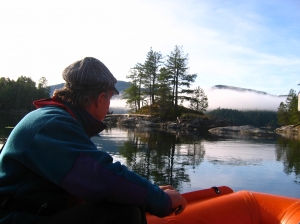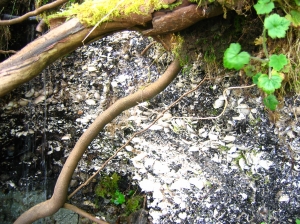Explore a New Wilderness Park on Quadra Island
A new wilderness park, a place with lots of history, was announced last month by the BC Parks Branch. They’ve secured 395 hectares of land, a jigsaw puzzle piece that lies at the heart of two existing parks on north Quadra Island. The funding arrangements required years of negotiation and a coalition of donors, including islanders, but it’s a prize well worth the effort!
Plan a hike or a kayak trip to celebrate. A great day hike starts near the end of the Granite Bay Road, on the trail to Newton Lake. At the lake follow the sign posted route for a left fork that veers north and down a steep hill past a waterfall and on to Small Inlet. This is where the trail reaches the new park, taking you to a viewpoint that overlooks islets near the head of Small Inlet. The trail continues west to cross Quadra Island’s narrowest point—from Small Inlet to Waiatt Bay—on a centuries old portage route.
Ancient Aboriginal Village Sites
The clam shell midden (refuse heap) at Waiatt Bay, evidence of a former aboriginal village site, is one of many in this area. These protected waters are rich in marine life. It’s the tremendous rush of tide in the passages that surround north Quadra that accounts for this. The tide can run at 15 knots in Okisollo Channel, flushing and oxygenating the waters of Small Inlet and the Octopus Islands. The aboriginal people cleared and tended clam beds here, piling rocks to create walls at the low tideline. The result was perfect clam habitat within the buildup of sludge on the tidal flats The best time to see these “clam gardens” is during the lowest tides of the year in mid-June.
The full walk, from the trail head just off the Granite Bay Road to Waiatt Bay, takes four or five hours return, depending upon your pace. There are some steep areas. The trail starts with a climb up a former logging road, and passes several small lakes before it hits the opal blue waters of Newton Lake. This is a great place for a swim in summer, with a choice of rocky promontories and the call of the resident loons.
Another way to access the new park is by water. A paddle from Granite Bay dock to the head of Small Inlet is a perfect day trip. You’ll pass the white shell beach of Green Island (or Shell Island), a former aboriginal defensive site, and it’s worth a slight detour to see Orchard Bay, with its grassy headland, just off the north entrance of Small Inlet. This is the largest aboriginal village site in the entire region, and has a terrific example of a clam garden.
Boating Routes to the New Park
You have options at the head of Small Inlet. You can hike up past the falls to Newton Lake, or take the 30-minute walk across Quadra Island on the Small Inlet to Waiatt Bay portage. Don’t miss the bubbling pool at the Small Inlet trail head, fed by an underground spring. This end of the trail will be a riot of bright yellow skunk cabbages at this time of year.
You can also launch your boat at the end of Surge Narrows Road, with its steep access. (Or better yet, why not rent kayaks from nearby Coast Mountain Expeditions.) Time both your departure and return for slack tide in Beasley Pass, unless you like a boiling sea, and continue on for several hours to the Octopus Islands Marine Park. Consider a late June trip when you can check out the clam gardens.
You’ll see signs of century-old logging throughout this region and on the portage route of the new park, which served as an oxen skid trail in the 1880s when young R.D. Merrill bought the land for its timber. The property remained in this multi-generation logging family for 130 years. Thanks to the purchase of this land, the second growth trees of this exceptionally beautiful wilderness area will remain intact for generations to come.
Place Names
Very few of the original aboriginal place names have been preserved on Quadra Island, but north Quadra Island is an exception. Here’s some of the names still in use:
• Okisollo Channel: “passage through”.
• Waiatt Bay: has been translated to mean different things, mainly by Kwakwala speakers. Some have said it means “place that has herring”, another said it meant “that which has a river.”
• Kanish Bay: translates to a shape like a narrow waist, which marks the transition from Granite Bay to Kanish Bay.


